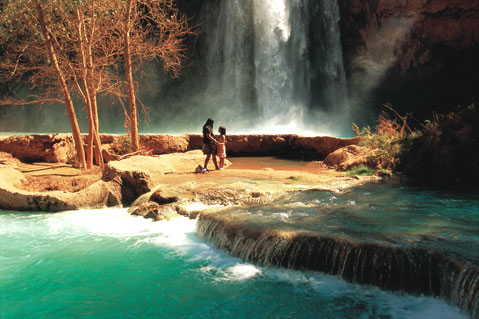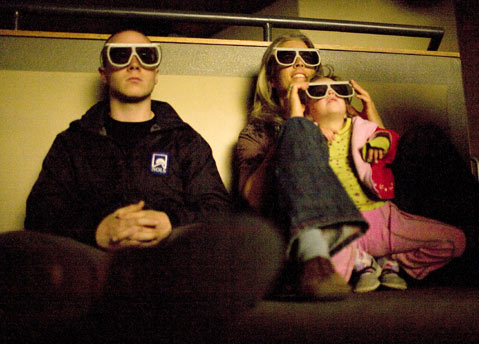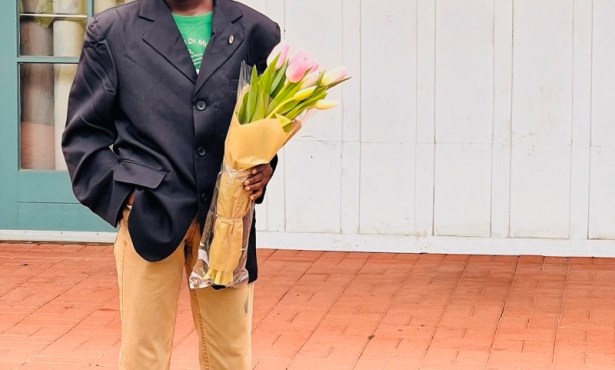Enlarging the Change
Mountainfilm in Telluride 2008

Mountainfilm in Telluride-which began thirty years ago as a way for some avid mountaineers to screen climbing documentaries on Memorial Day weekend-has grown in scope and impact over the decades until blossoming this year under the leadership of David Holbrooke into a combination eco-film festival and alternative think tank for progressive minds from the environmental movement, media, politics, and the arts. The mountain adventure community and explorers of all kinds are still well represented, but today the festival encompasses an outlook that gives the widest possible interpretation of the event’s motto-“celebrating the indomitable spirit.” Under the banner of the National Geographic and many other sponsors, a substantial crowd of adventurous individuals shared three days of packed screening rooms and animated discussions with such various contemporary sages as Christiane Amanpour, Pico Iyer, Richard Holbrooke, Jamie Rubin, Samantha Power, Eugene Jarecki, Alex Gibney, and Wade Davis. Films screened this year included Gibney’s Academy Award-winning documentary on Abu Ghraib, Taxi to the Dark Side, along with his new film, Gonzo, a documentary on Hunter S. Thompson, Lauren Dunn’s Texas development doc The Unforeseen, Stranded: I’ve Come From a Plane That Has Crashed in the Andes, Drowning River, about the Glen Canyon dam on the Colorado River, and Grand Canyon Adventure: River at Risk 3D, a new IMAX 3D film on running the Colorado featuring Robert Kennedy, Jr., Wade Davis, and their teenage daughters negotiating wild rapids in inflatable boats and kayaks. The two main themes of this year’s event were the importance of water to the future of the planet, and the ongoing international issue of human slavery. In addition to all the fine films screened and the many question and answer sessions that followed them, the festival also included a number of panel discussions on world politics and human rights.

Telluride itself explains part of the appeal that Mountainfilm holds for regulars and newcomers alike. Nestled in a beautiful valley high in southwestern Colorado, the town is ringed by North America’s largest concentration of 13,000- and 14,000-foot peaks. Even landing on the tiny airport’s single runway resembles an extreme winter sport. The runway slopes downhill at a pitch that would earn it an intermediate blue square at many less challenging ski resorts. The action during the festival takes place mostly within a few square blocks of the old mining town, with a handful of events held at the Mountain Village, which is accessible both by road and a free gondola service. When I arrived on Friday, May 23, it was snowing lightly at the airport, something that came as a bit of a shock to this southern Californian. Although I soon became acclimated to the weather, which warmed up nicely by Sunday, the altitude of approximately 8700 feet in the town of Telluride continued to take its toll well into the second day.
The spirit of this lofty little town manifests in dozens of ways that, added together, make for a great escape from the world below. Adults play Frisbee and hacky-sack on the town green with the patience and delight of teenagers. Dogs and bicycles are everywhere, along with fleece climbing jackets, baggy pants, and hiking boots. At the base of the gondola I witnessed slacklining, a new (to me) athletic endeavor that involves stringing an inch-wide, thirty foot-long strip of heavy-duty nylon web between two posts at a height of about five feet, then tightrope walking along it in slow motion. It looks really difficult. On Saturday afternoon, bicycle polo players took to a blocked-off portion of the main drag for several hours of their hybrid of BMX/mountain biking and polo.
The opening night films that drew the most attention were Stranded, about the 1972 crash of a Uruguayan rugby team high in the Chilean Andes, an event that left them to fend for themselves and, famously, commit cannibalism, for over 72 days in the snow, and Gonzo, Alex Gibney’s forthcoming Hunter S. Thompson documentary. I ended up at Stranded, where Nando Parrado, one of the survivors of the crash, and one of the two men responsible for walking out over the mountains and saving the rest of the survivors, was present to answer questions. The film, which some of you may have seen here during the Santa Barbara International Film Festival, includes dramatic re-enactments in the form of action sequences and still photos that are integrated seamlessly with the original footage available from 1972.
At first it was hard to get used to the idea that these men were heroic. After all, the eating of human flesh remains perhaps the most universal taboo. Yet after spending more than two hours in the darkened theater absorbing the enormity of their fate and the extraordinary tenacity that allowed them to survive, even the inevitable bad jokes lost their appeal, giving way instead to a sense of awe and wonder at such an extreme example of what the will to live can accomplish. Stranded is an elegant film, and it achieves a dignity that no other treatment of this often-discussed incident has approached.
The Unforeseen gave another example of the advanced state that documentary film style has reached as of 2008. Lauren Dunn’s film about the decades-long fight over large-scale housing development at Barton Springs aquifer near Austin, Texas takes a daringly creative and impressionistic approach to subjects-water and development-that will resound with great force among residents of Santa Barbara.
Eschewing conventional narrative voice-over in favor of the direct cinema technique of letting the characters do all the talking, The Unforeseen offers a remarkably thorough and balanced account of one of the greatest land and water battles ever waged in this country. Beginning with images of Texans cavorting in the natural pools of Barton Springs in the 1950s and 1960s, Dunn incrementally raises the stakes by introducing her audience to the people whose lives and work are responsible for the very different situation that obtains in Barton Springs today. Although the film takes a clear anti-development stance, Circle C Ranch mega-developer Gary Bradley is nevertheless given a generous amount of screen time to convey his own journey from the lower middle class in an impoverished small Texas town to the heights of real estate development success, then bankruptcy, and beyond to the uncertain future he faces today.
In the film’s most revealing sequence, Dick Brown, the lobbyist responsible for reversing the grass roots legislation that protected Barton Springs, is shown carefully piecing together and painting a plastic model of an air force bomber. The Barton Springs story has everything, from early environmentalists successfully lobbying to stop development, to unsympathetic state legislators and hostile property rights enthusiasts overturning the environmentalists’ landmark local policy. In the end, property rights and power politics won out over local sentiment and ecological science, resulting in a damaged Austin water supply and a devastating explosion of truly hideous subdivisions. If you have any interest in the history and politics of water and development, you owe it to yourself to catch The Unforeseen when it makes its way to our area. Executive producers Robert Redford and Terence Malick are to be commended for encouraging Dunn to make a nuanced and creative film out of this material, rather than a simple agitprop filmstrip.
Drowning River, a short documentary by ML Lincoln that had the feeling of a work in progress, was the first of two films and several panels to address the fascinating and crucial subject of Glen Canyon Dam and its impact on the Colorado River and the entire American southwest. The star of Drowning River, Katie Lee, is a river-rights activist, singer-songwriter, firebrand, and sometime nudist who has been exploring the Colorado since the early 1950s. Lee was on hand for the screening, and, true to form, she did not wait until the film was over to start voicing her opinions, some of which she stated quite forcibly while the picture was still rolling. Lee and her cohorts, particularly writer and wilderness advocate Charles Bowden, are not just direct descendants, but actual contemporaries and participants in the late Edward Abbey’s legendary “monkey wrench gang.” They take their environmentalism very seriously and with a welcome dose of old-fashioned bravado. While not everyone will feel as Lee does that the path to a sustainable future is “simple” to quote Lee, “Stop having kids!” it is hard not to admire such uncompromising iconoclasm, particularly in the service of such an elemental issue as water in the west.
The issue of Glen Canyon Dam and its legacy was articulated in a very different but complementary register the next morning by Freeman-MacGillivray’s IMAX 3D film, Grand Canyon Adventure: River at Risk 3D. This film drew the festival’s largest and most enthusiastic audience, and was followed by one of the best panels, moderated by Los Angeles-based eco-historian Wade Graham. The film tells the story of two father-daughter pairs, Wade and Tara Davis and Robert and Kick Kennedy, as they join Native American river guide Shana Watahomigie for a run on the Colorado. The 3-D was a little off-kilter from my side balcony seat-maybe more like 2.5D-but the film was thrilling nonetheless, and extremely effective in focusing the single biggest environmental issue now facing the American southwest: the public and private management of limited water resources.©To understand contemporary life in this part of the world, it is necessary to know the story of Glen Canyon Dam, the giant structure that formed Lake Powell in Arizona when it was constructed in 1963. Glen Canyon Dam was what one panelist called “the first purely political dam.” It was constructed in order to block the southern states, particularly California, from monopolizing the resources of the mighty Colorado. In addition to creating a giant man-made lake, the dam also succeeded in “drowning” the river that once flowed through that area, forever disturbing the fragile ecology of native plants and animals indigenous to that part of the world.
As the intrepid Davis and Kennedy team make their way down from Lake Powell towards the Grand Canyon, we learn much that is truly shocking about the intense destruction this dam has visited on a once vital culture, the Anasazi. These Native Americans grew their crops on the sandbars of the Grand Canyon, and stored grain in special caves dug into the canyon’s walls. Today the river runs unnaturally clean south of Lake Powell, depriving the ecosystem of sediment, an essential element in the maintenance of a wide variety of life forms. Davis, an ethnobotanist and the author of many books about native use of plants around the world, points out the relics of an earlier way of life, now rendered impossible by the giant dam upstream. ©The taming of the Colorado of course does not begin and end with the Glen Canyon dam. Further down the river is the Hoover Dam which, when it was built, was the largest man-made structure in the history of the planet. Between these two great dams, the single most important source of water in the arid part of North America west of the 100th meridian has been domesticated and denatured, rendered into a shadow of its former robust ecological whole. The Colorado River delta, once a fertile area around the Sea of Cortez, is today a scratchy toxic trickle rather than the life-giving marshland it was in previous decades and centuries.
As an exhilarated audience took off their special 3D glasses and settled in for the discussion, Wade Davis delivered the weekend’s single most provocative short speech, using his anthropological training and distinctive take on history to portray the multifaceted cultural process that is the greening of the American west. Sparks flew as Davis tracked this national mission to its source in the Mormon settlement in Utah and its goal of greening the desert, a project which he described as demonstrating “the power of the hejira” and offering “a crude coefficient for the agony of the Mormon journey.” The other panelists contributing to this fast-paced exploration of the “ideology of transformation” and its impact on western water issues included Brad Udall, Dave Wegner, and moderator Wade Graham. It amounted to a mini-seminar on water in the west, and no one who attended could possibly have left with the same attitude towards water that they had entered with.
Less than an hour later, the same stage was occupied by an equally brilliant group discussing another giant topic-American foreign policy in the years 2007-2008. Moderator Eugene Jarecki’s documentary Why We Fight won the 2005 Grand Prize at Sundance, and he is at work on the final chapters of a new book, The American Way of War, and How It Lost Its Way. Jarecki was joined by CNN’s lead international correspondent, Christiane Amanpour, her husband and former Clinton White House official Jamie Rubin, and Ambassador Richard Holbrooke, a veteran of three Democratic administrations and a long-time power broker among the Democratic Party elite.
Responding to an ambitious, three-part initial question from Jarecki–“How do we define national defense? How do we define national security? Are they the same?”-the panel was off on a freewheeling and far-ranging two hours of powerfully informed talk. Holbrooke, who qualified his remarks by saying that, no matter how high (almost 9,000 feet) the altitude in Telluride, he did not want to be understood as looking down on the rest of America, asserted that the upcoming presidential contest will be the most consequential single American election since 1968. He urged everyone to get out and not only vote, but actively support the Democratic candidate by keeping focused on what he sees as the election’s defining issue, the war in Iraq.
Jamie Rubin, who has spent most of the last 8 years abroad, made the point that it was the re-election of George W. Bush in 2004 that caused the international community to lower its opinion not just of the American leadership, but also of the American public. He linked this loss of respect to an erosion of our ability to negotiate on the international stage, and quoted the founding fathers in their support of maintaining “a decent respect for the opinions of mankind.” Thus the overall impact of Bush’s foreign policy, according to Rubin, has been a loss of national security.
Christiane Amanpour made a subtle change of direction in her remarks, which she began by recognizing that people in the Islamic countries she reports from still look to America for values and opportunities. She then offered a finer-grained analysis of the American reputation than her husband had ventured, speaking of the alienation not of the entire world, but specifically those people who have a stake in areas where democracy has not lead to what the United States considers “sympathetic” regimes. She thinks that many people in the Islamic world value democracy, but that their experience of it may not agree culturally with our American image of what democracy should promote. Amanpour went on to stress the relative failure of her own sector, the American media, in fulfilling its mission of creating an informed public. She called for increased funding of public broadcasting as one potential answer to this problem of cultivating an engaged audience for international affairs, and reiterated the consensus of the panel in a particularly succinct phrase by saying that there is a “desire on the part of the rest of the world to be engaged by America on a basis of respect and dignity.”
It was truly fascinating to observe the personal dynamics among these four intellectual power players. At one point, Christiane Amanpour brought down the house with an impromptu remark about the fact that she sometimes felt left out of the discussion. “I never thought I would have to say this,” she began, “but what am I, chopped liver?” Holbrooke, Rubin, and Jarecki did eventually yield something like equal time to Amanpour, who was clearly the big draw at the event and cut an arresting figure throughout the weekend as she greeted and conversed with legions of admirers. She has a down to earth quality as well as directness and passion that makes her involvement in international human rights that absolutely inspiring.
At any ordinary festival, this would have been enough for one weekend, but at Mountainfilm, the programs are every bit as intense as the surrounding peaks. Early Monday morning I was back in a standing room only audience for the world premiere of Carol Black’s Schooling the World: The White Man’s Last Burden. This 50-minute documentary, which was beautifully shot on location in India by Telluride residents Ben Knight and Jim Hurst, looks at the paradoxes of English-language education as it is administered to the indigenous cultures of the Himalayas. Students who have left their traditional homes to study in the city are shown performing highly regimented calisthenics in a giant courtyard, and then sitting listlessly in classrooms as alienated teachers attempt to coax them into minimal participation in ill-fitting lessons. The implications of this short film are enormous, and the discussion it engendered, which once again included the ever-insightful Wade Davis, made it a highlight of the festival. ©Mountainfilm succeeds in large part due to the creative critical mass that occurs when this many intelligent people gather in a small town setting to think and speak about the world’s most compelling issues. Telluride’s cozy layout never leaves anyone more than a few short steps from a friendly doorway. Among the most stimulating discussions to occur were those that took place on the porches and porch swings of the town’s rental properties, the majority of which were occupied by convivial groups determined to get the most out of what the weekend had to offer. Whether that meant cramming in as many films as possible, attending the human rights panels and talking to the experts afterwards, or hiking up Tomboy trail beyond the treeline to look at the remains of an avalanche, Mountainfilm in Telluride gave everyone involved what they came for and more.



